Proposal talk:Advertising
Registration Authorities
In some areas advertising is subject to permit by a local authority. In the proposal please highlight more clearly the use of the ref=* tag, so that visible registration numbers are recorded. Later data mining efforts can then compare the official list of signs with that found on the ground. Brycenesbitt
- Yes, for instance in Italy and Germany advertising is subject to permit (actually a "building permit" similar to that you need to build a house and covered by the same law), but what is very different is that in Italy (at least in the central part I know best) there are lots of abusive signs (those erected without any permit) while in Germany you'd be very soon in trouble if you tried to do this. I'd suggest to add
informal=yesto those signs that are put without formal permission. I agree thatref=*for the registration number is also nice to put, but I wouldn't want to rely on the presence of this tag alone. --Dieterdreist (talk) 10:19, 3 March 2015 (UTC)
- Yes in France we are supposed to have what is called a 'butteau' on each advertising device, it gives the reference of the device.--Barnes38
- The french regulations on outdoor advertising can be found here. --Barnes38 16:02, 22 Aug 2015 (UTC)
Amenity
- I think (and it was said in the Tagging mail list) a
amenity=advertisingtag may be used first, and after to precise useadvertising=*and others tags (operator=*, a tag to indicate if everybody can put ad freely...) --Dri60 12:31, 7 May 2011 (BST)
- I don't see any advantages in the use an additional tag (amenity=advertising). It's clearly more work, so what's the motivation for this suggestion? --Tordanik 16:09, 7 May 2011 (BST)
- It's not really a question of advantages, but an advert sign is an amenity, so we may show first that is an amenity. Many objects we can tag works like that : indicate the category (shop, landuse, amenity...) and the object (supermarket, cemetery, fire_hydrant), and after we precise informations about the object (operator, website, type, ...). I don't see why an advert sign may not follow this commonly used system. --Dri60 09:39, 8 May 2011 (BST)
- I don't think that advertising is an amenity. What about "nuisance"? So this would be nuisance=advertising, advertising=column. I also fail to see an advantage in this tagging. --Dieterdreist 10:35, 8 May 2011 (BST)
- What I want to say is that others objects are first in a "big category" (shop,amenity...), and
advertising=*looks more like a tag to precise the object's type. We don't tag a clock just withclock=clock_type, but withamenity=clock, and after others tags to precise. Amenity could not be the good category, but in my mind we need to put the advert tag in a "big category". It's not a question of advantages, it's more a question of habit. --Dri60 13:27, 8 May 2011 (BST)- I think that "advertising" has the potential to be its own "big category" --Dieterdreist 13:00, 9 May 2011 (BST)
- Well, may be true when we see all sorts of adverts... so why not ;-) --Dri60 17:53, 9 May 2011 (BST)
- How about spam=advertising + advertising=whatever? .. But seriously: I like the proposal and IMO ads must be separated from amenity (and/or man_made / any other). And to anyone who doubts the meaningfulness of mapping them altogether: They are very important landmarks in many places. --JaakkoH 04:11, 9 July 2012 (BST)
- I think that "advertising" has the potential to be its own "big category" --Dieterdreist 13:00, 9 May 2011 (BST)
- What I want to say is that others objects are first in a "big category" (shop,amenity...), and
- I don't think that advertising is an amenity. What about "nuisance"? So this would be nuisance=advertising, advertising=column. I also fail to see an advantage in this tagging. --Dieterdreist 10:35, 8 May 2011 (BST)
- It's not really a question of advantages, but an advert sign is an amenity, so we may show first that is an amenity. Many objects we can tag works like that : indicate the category (shop, landuse, amenity...) and the object (supermarket, cemetery, fire_hydrant), and after we precise informations about the object (operator, website, type, ...). I don't see why an advert sign may not follow this commonly used system. --Dri60 09:39, 8 May 2011 (BST)
- Advertising devices are not amenity on my opinion, if they can provide information (legal information, opinion, warning to user, inform on events), vast majority of advertising devices remain commercial advertisings, a lot of them are illegal devices, do not take into account regulations, and provide nuisance to people and landscape. I m in favour of a specific tag 'advertising' with several types : billboard/poster_box/sign/indication/column/flag/ etc. --Barnes38 13:15, 22 Aug 2015 (BST)
Difference between sign and billboard
- I'm not a well english speaker, so could you explain what is the difference between a advertising sign and a advertising billboard. Is it size ? --Dri60 12:48, 7 May 2011 (BST)
- In German I would translate those as "Schild" (sign) and "Plakatwand"/"Werbetafel" (billboard).--Dieterdreist 10:38, 8 May 2011 (BST)
- I see the difference, could be interesting precise it on the proposal page --Dri60 13:31, 8 May 2011 (BST)
- Advertising signs are "on-premise advertising devices", the are located on the premises where the activity take place (roof, façade, front) or very close to them (garden, entrance). Advertising boards are located far away from the place where the advertised activity takes place, in open country, alongside roads, where flows of people pass. In the middle between 'advertising signs' and 'advertising boards', there are 'advertising indications'. Advertising indications are located close from the premises where the advertised activity takes place, but there are not exactly on the premises, they are "off-premise advertising devices". They indicate to the people that they are getting close from something, they indicate the direction to, they inform the proximity of something, they tell 'you should not miss this while passing around', etc. In France, there are two specific words for "on-premise advertising devices" (we say "enseignes"), and "off-premise advertising devices" (we say "pré-enseignes"), and their regulations are very different. That's why I propose to distinguish them while tagging, and to have "advertising=sign" for on-premise advertising devices, and 'advertising=indication' for off-premise advertising devices. --Barnes38 14:12 22 August 2015 (BST)
Some details
Hi, thanks for creating this proposal :) To me there are just a few ideas that might be included in some some way:
amenity=clockthere are some clocks that have a rotating advertising build inadvertising=flagpoleor just flagadvertising=wall_paintingfor big images/banners painted or mounted on one side of a building. The node for this item might be part of the corresponding building- what about adding logos of companies to their buildings by using
advertising=logo - there are billboards with rotating banners along a highway, might this be a usefull information?
See also wikipedia:Out-of-home advertising --!i! ![]() 08:17, 8 May 2011 (BST)
08:17, 8 May 2011 (BST)
- Thank you for these suggestions, I added most of them. Logos could often be tagged as sign, but there might also be sculptures (e.g. characters representing a brand), which I added. For billboards with rotating banners (or also those which have several smaller revolving elements, often with triangular section) I'd use animated=yes.--Dieterdreist 10:49, 8 May 2011 (BST)
- Yes to be a little more precise, "operated=no" by default, "operated=yes" if advertising device is animated in any way. We could precise the type of animation by having "operated=trivision_blade" if three different panels are displayed by rotating triangular blades, "operated=trivision_poster" if three posters are diplayed by rotation of them. We could have "operated=rotating" for column as it occurs sometimes. This could be refined in future. (See animated).--Barnes38 14:18, 22 Aug 2015 (BST)
Overlap with other features
Some of the suggestions overlap with existing tags. That's most clearly the case for advertising=flagpole, which overlaps with man_made=flagpole (600 uses). A subtag for man_made=flagpole would be a better idea - the proposal already includes the suggestion to tag the operator, as well as a distinction between signal, governmental, ... flags, so advertising/company flags could fit in there.
I can also imagine that the distinction between advertising=sculpture and artwork_type=sculpture isn't always obvious, but I'm not sure what to do about that. --Tordanik 11:54, 8 May 2011 (BST)
- Thank you for these comments. I updated flagpole. I don't think that it is a big problem with sculptures beein mappable as art or advertisement (or even both). I'd consider it a feature that you can tag them as both if there is an edge case.--Dieterdreist 13:04, 9 May 2011 (BST)
- Mentioning
man_made=flagpoleis an improvement, thanks for that. Any progress about the flag type issue? It's still described as "has to be evaluated". I consider it unlikely that we will ever use something like national=flag, so advertising=flag would be very different from the tagging for other flat types. Therefore, I'd prefer using the [flag_]type key, which also fits nicely into the "select the type of the object, then add attributes" mental model encouraged by presets. --Tordanik 20:51, 3 June 2011 (BST)
- Mentioning
- IMO there's two separate attributes: one is the physical structure (a flagpole, a sheet of metal, a pillar/column, a building wall etc.), of which only flagpoles and building outlines have been entered so far beyond solitary cases; the other is "this is used for advertising", with the values implying some physical structure to contain said advertisement - and with the proposed values, even defining said structure. One could, and even should, tag each billboard with both
advertising=billboardandman_made=billboard(209 uses today). Just as shops occupying one building are both shop=* + building=*. The alternative approach would be to always tag the physical structure carrying the advertising, i.e. man_made=billboard/column/flagpole/sign/screen/.. + advertising=yes - or with the advertising key describing some other significant characteristic of the advertising; not that I could right now even come up with anything reasonable. First up would be permanent advertising (wall paintings, logos) vs. adverts that are changed every few weeks, months at most. I.e. =yes/permanent/changing. - I'll admit that this would incur extra tags on flagpoles, if someone starts classifying them separately, but extraneous tags aren't fatal. That'd be man_made=flagpole +
flag=advertising/national/signal/household pennant/...+ advertising=flag. Alv 13:50, 4 June 2011 (BST)
- IMO there's two separate attributes: one is the physical structure (a flagpole, a sheet of metal, a pillar/column, a building wall etc.), of which only flagpoles and building outlines have been entered so far beyond solitary cases; the other is "this is used for advertising", with the values implying some physical structure to contain said advertisement - and with the proposed values, even defining said structure. One could, and even should, tag each billboard with both
- 'Advertising flags' and 'flags' are very different in shape and rational. National flags belongs to everybody, are part of the community, while commercial or advertising flags are private, and for the sole benefit of private interest. Advertising flags are often very large, hanged on buildings, on trees, or on masts directly put on the ground, alongside the roads. National flags are on masts, around memorial, public buildings, monuments... Gathering all advertising devices into one specific tag 'advertising' and having one specific value for flag seems a good idea to me. So keeping 'advertising' with different values like 'billboard' 'poster_box' 'flag' 'wall_painting' 'column' etc.--Barnes38 14:34 22 Aug 2015 (BST)
- The shape, which should imo be the primary factor for classification with tags, is not necessarily any different. Perhaps we are thinking about different types of "advertising flags" – flags on trees? – but I'm thinking of flags like these, which are very similar to national flags except for what is printed on the flag. And sometimes you even have flagpoles that alternate between advertising flags and national flags, such as those operated by our local university. --Tordanik 12:53, 22 August 2015 (UTC)
- ok for the shape, your examples are clear! Here what we want to tag are the various types of advertising. One of them is 'flag', other types are 'board', 'column', etc--Barnes38 15:08 22 Aug 2015 (BST)
- So, you admit that I have refuted one of your arguments, and your reaction is to just reiterate your point? The matter of the fact is that two tagging approaches are conflicting here: The flag tagging scheme is trying to map all types of flags, and this tagging scheme is trying to map all types of advertising. Now you could just use multiple "main" tags to map an advertising flag, but that's worse than either of the options imo. And considering that advertising tagging is still only a proposal, it would be easier to adapt than the existing flag tagging. --Tordanik 12:48, 25 August 2015 (UTC)
Two-sided billboards
Suggestion: Distinguish between one-sided and two-sided billboards with two_sided=yes. --Tordanik 02:25, 10 May 2011 (BST)
- Yes I propose to have a subtag called 'faces' indicating the number of faces of the advertising device. By default, it is 1. But we have a lot of advertising devices with 'faces=2', and we can have sometimes, for example on the parking lots of shopping centers, some advertising devices with 3 faces of 4 faces, so that there is one face for each flow of people. The 'faces' attributes could then take the following values: '1' '2' '3' '4'.--Barnes38 14:39, 22 Aug 2015 (BST)
Electoral billboard
In Italy during elections some billboards are devoted to electoral advertising and they're regulated with specific laws. Do you think we can use a specific attribute? --wiso 12:01, 6 September 2011 (BST)
- We should distinguish the advertising devices from the advertising messages that is displayed, and have one specific attribute (or sub-attribute) for the message, for example 'message'. Vast majority of advertising devices have a commercial message, and the default value of the 'message' attribute would then be 'commercial'. But we can have several other types of messages (see Ranking_based_on_the_message and message.)--Barnes38 14:45, 22 Aug 2015 (BST)
Public billboard
In France, we have some "free" billboards, I'm pretty sure it exists in many other countries. These are large boards, usually labeled "Expression Libre" (roughly translate to "free speech") and are provided by the city/local government. On these boards, anyone can come and stick his own poster, without asking any permission. They are mostly used by local NGO (social, cultural) to advertise upcoming events (parties, concerts, fair, ...).
A new subtag could be used to describe this but I would suggest using the common access tag:
access=private: you need to contact the operatoraccess=yes: free billboard as describe aboveaccess=permissive: I would use this for smaller boards that can be found in the hall of some public buildings (mall, community center, ...) where anyone can add a poster without having to pay but need to ask permission first at the reception desk.
Gbassiere 10:50, 11 September 2011 (BST)
- Good point, but this one I know here in Germany are mostly private because for official announcements, only --!i!
 12:41, 13 September 2011 (BST)
12:41, 13 September 2011 (BST)
- I agree with this 'access' tag and the thee values proposed. --Barnes38 14:50, 22 Aug 2015 (BST)
Bulletin Board
For a very small bulletin board I would suggest advertising=bulletin_board. At the moment amenity=bulletin_board is used for this (but only 10 times). --WalterSchloegl 21:38, 25 January 2012 (UTC)
Bulletin billboard have another meaning in other country like US, see here. I propose to have either a tag for format or for size as indicated here.--Barnes38 15:15, 22 Aug 2015 (BST)
Drawing the line
In a sense an advertising=billboard is just a huge advertising=sign, right? To make it easier for mappers to classify the stuff they see, I've started this table below:
| image | agreed tag | comments |
|---|---|---|
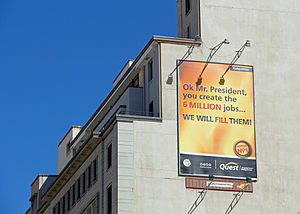 (replaced due to copyright reasons) (replaced due to copyright reasons)
|
advertising=billboard lit=yes (luminuous=yes has no uses to date)
|
|

|
advertising=poster_box + lit=yes
|
In essence same as below, just integrated into a bus stop shelter: a lit, two-sided advert - might have a mechanism to switch between three adverts on a rolled paper, but mostly just static printouts under the glass. Is it a billboard or a sign, or something else? |
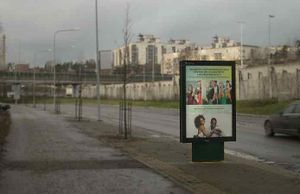
|
advertising=poster_box + lit=yes
|
It's lit, two-sided, usually has three adverts on a rolled paper and alternates between them. It's not a column, nor a screen, but is it a billboard or a sign, or something else? |
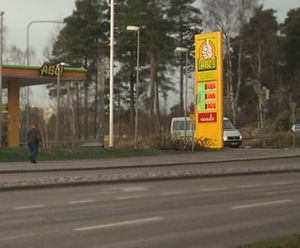
|
advertising|pylon | As much as wall paintings are advertising, so are these pylons/"beacons" that advertise the location of a shop/service. They can be enormous for a hypermarket. |
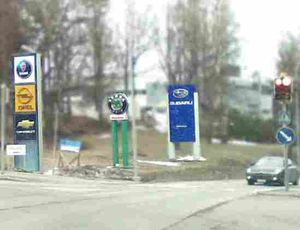
|
Three towers with logos - these are probably signs, but are they? Only a bit smaller than the one above. | |
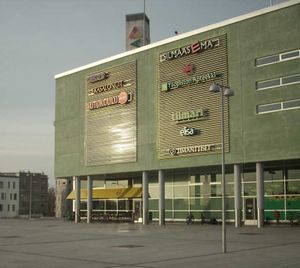
|
advertising=sign + lit=yes
|
Lit-from-within signs. Like the ones above, these too advertise the location of a shop/service. |

|
advertising=sign + lit=yes
|
As above, just smaller and sticking out of the wall, instead of being parallel to the wall. |
I'll add some more cases, once I get to photograph them. Feel free to add your examples, too.Alv 15:06, 24 November 2011 (UTC)
- Imo it's hard to see anything on the pictures. The background is blurred, the objects themselves are blurred, so it's hard to build a mental model of the coutours, size and orientation of the objects. The seams of sharpness around the objects are especially irritating. Maybe it's just me, though. --Tordanik 15:43, 24 November 2011 (UTC)
- Maybe I blurred some parts too much. On the objects only the commercial message itself is blurred. I don't think the originals would be usable as photos describing some possible new values of the key, hence a real quick attempt at manipulation. I'll see if I have the resources to try again, if nobody comes up with constructive ideas before that. Alv 16:16, 24 November 2011 (UTC)
- The advertisement signs sticking out and hanging from the building are called "blade signs". [1] I'd tag as
advertising=blade--filbertkm (talk) 08:51, 28 October 2012 (UTC)
- The advertisement signs sticking out and hanging from the building are called "blade signs". [1] I'd tag as
- Maybe I blurred some parts too much. On the objects only the commercial message itself is blurred. I don't think the originals would be usable as photos describing some possible new values of the key, hence a real quick attempt at manipulation. I'll see if I have the resources to try again, if nobody comes up with constructive ideas before that. Alv 16:16, 24 November 2011 (UTC)
- For the distinction between 'advertising board' and 'advertising sign' (and 'advertising indication'), can you see here and here ?--Barnes38 15:18, 22 Aug 2015 (UTC)
Removed "Suggested combinations"
I've removed several "Suggested combinations" that were actually new tags, rather than existing tags that go well with the proposed additions. These should be defined in their own section, complete with proper value lists. In the case of surface and type, they should also use different key names, instead of re-using existing keys with a different meaning. --Tordanik 21:58, 26 March 2012 (BST)
How to tag rotating Advertising columns?
I have a self-rotating Advertising column in my Tagging-Area. I'd like to tag the "rotation"-feature of it. By the way: It is awry (maybe the false word, german "schief") - is it possible to tag that?
Because i guess my english is hard to understand again in german:
Ich habe eine selbstdrehend Litfasssäule in meinem Tagging-Bereich, bei der ich gerne das "Dreh-Feature" eintragen möchte. "animated" passt da wohl nicht ganz, da dies imo eher auf (nervende) Animationen abzielt. Btw: Gibt es eine Möglichkeit, ein schiefes Objekt als "schief" einzutragen? --rayquaza 17:27, 22 May 2012 (BST)
- I've used
revolving=yes. Is it supposed to be "schief" or should it stand upright? Anyway, if you don't find anything similar with taginfo already in use, just start using something, liketilted=yesmaybe? Alv 17:57, 22 May 2012 (BST)- Some of them are revolving. Added revolving to the subtag section. --EinKonstanzer (talk) 16:36, 5 June 2015 (UTC)
- We could have 'advertising=column' and 'animated=yes' or 'animated=rotating' (See here and here.)--Barnes38 15:26, 22 Aug 2015 (UTC)
Icon suggestion
Very high zoom would render : ![]() SVG version to be used in https://github.com/twain47/Open-SVG-Map-Icons.git
SVG version to be used in https://github.com/twain47/Open-SVG-Map-Icons.git
separation between physical thing and it's use
To answer the above questions about "political billboard" "public billboard" or "clock with advertising on it" or even "walls with advertising on it" (and what else) I suggest that the physical support and what is displayed should be recorded independently in two tags.
- advertising=billboard => man_made=billboard + display=advertising/political/information/varying/empty...
- advertising=wall_painting => barrier=wall + display=advertising/...
- advertising=flag => mand_made=flag_pole + display=advertising/...
... sletuffe 21:20, 31 October 2012 (UTC)
- Yes I agree with this separation of things between the device on one side, and the message on the other side (See here). --Barnes38 15:28, 22 Aug 2015 (UTC)
billboard vs hoarding
As much as I know British should be preferd. Billboard seems to be rather American but perhaps is already well known in Britain? I'm non-native so I can't say.
small_billboards
Ok, so what is a "small billboard"? And why does it have a monopoly on billboard_count? It's the only value that doesn't have an image yet, so the only thing I can imagine is a regular billboard with small width=* or height=*. Please enlighten me. --Tordanik 08:38, 25 April 2014 (UTC)
- Yes I propose to have on one side the type of device for advertising (advertising=billboard/poster_box/flag/column/scupture/wall_painting to give the mains of them), then to have a tag to tell the format or the size, depending on the country it can be better to use 'format' or 'size' I suppose. (See Size or format.)--Barnes38 15:33, 22 Aug 2015 (UTC)
No longer just a Proposal
I think this should to some extent separately be documented on Key:advertising at least the most common tags that are in use. This is somewhat turning into a Key: page on its owm. --AndiG88 (talk) 12:30, 5 August 2014 (UTC)
- The column and billboard values are definitely in use. I see you have already created pages for them. The documentation is solid, however I wonder why you chose the area=yes flag for billboards? I don't think this would work well in practice because the front side would no longer be clearly defined. --Tordanik 14:22, 6 August 2014 (UTC)
tourism & advertising
some poster_box in my city are used for tow things in one side a map of city or street and in other side advertising a have added tourism=information & advertising=poxter_box but how to set orientation for one and another? orientation:advertising= and orientation=tourism? -08:12, 8 November 2014 (UTC)
- This occurs everywhere. I propose to have 'advertising=poster_box' 'faces=2' 'message:front=commercial' message:reverse=information' (see here).--Barnes38 15:45, 22 Aug 2015 (UTC)
Text of the advertisement
EinKonstanzer added the suggestion of using advertisement:text for static inscriptions. In my opinion, it would be preferable to use the existing inscription=* instead. --Tordanik 18:52, 5 June 2015 (UTC)
No to advertising in OSM!
I am ok with recording the fact that there *is* a billboard or some advertising facility somewhere. I am also ok with recording the wording of a sign where it has "landmark" character, like a very big neon sign or something. But I am not ok with recording advertising "messsages" of individual POIs, like the stuff that SEO companies spam OSM with: "Providing Littleville's premier carpentry cleaning services since 1978, family-owned Dolly Polly Cleaning Co.'s aim is to satisfy each and every customer...". Whether there's an A4 printout with that message in the shop window or not, such advertising has no place in OSM, and if we are not very clear on what we tolerate, then this *will* be abused. I therefore strongly object to the "advertising:text" tag and its current description of "This can also be used for the advertising message of amenities, shops, ... For everthing that has a advertising message!" --Frederik Ramm (talk) 12:27, 13 June 2015 (UTC)
- Would you agree with using inscription (as I suggested above) for the text of prominent signs? The inscription key is also much more narrowly defined, so it would hopefully not invite SEO content. --Tordanik 16:19, 17 June 2015 (UTC)
- Maybe... perhaps the "advertising:text" wording is just not clear enough. Perhaps the whole feature should carry a huge disclaimer that goes: "This tag is intended to record (large) advertising installations. Any use of this tag that turns OpenStreetMap into a medium for advertising is strongly discouraged, and will be reverted. When in doubt, OpenStreetMap will err on the side of removing something that looks like advertising, not keeping it." - What I absolutely want to avoid is getting into discussions with stubborn SEO people who claim that their content is "covered by the rules". --Frederik Ramm (talk) 16:48, 17 June 2015 (UTC)
- I agree with 'Frederik Ramm'. Having advertising devices, sizes, characteristics in OSM could be interesting, they are part of the landscape, the are urban furnitures, they bring animation and information on one side, but they bring nuisances and can damage landscapes on the other side. As there are huge private financial interests and profits on them, it seems interesting to have an inventory on them, so that citizens can control their location, number, size, type and so one, then having them into OSM is very interesting. But keeping in OSM the advertising message (if static) itself does not seem very interesting to me. --Barnes38 15:56, 22 Aug 2015 (UTC)
- Same here. I concede we need to accurately describe significant ad installations (man_made=advertising?). But I definitely don't want marketers to even begin to think they can offer OSM editing as service for their clients. I'm quite sure use of an advertising=* key would be interpreted - wrongly and avariciously - that OSM is now accommodating advertising content. This can't work even if "narrowed" definitions are intended, because their worldview is so incompatible: OSM mappers want to describe reality, while marketers want to alter perceptions. I do not want to attract that conflict. Instead, let's strive to define tags so that advertising artefacts can only be "measured". I feel we should resist strongly any scheme that invites the conduction of a text campaign. Dle0 (talk) 02:49, 13 August 2016 (UTC)
Advertising draft : merge to be done
Another proposal based on this one, and maybe more global is drafted here., I ll work out on a merge. I ve tried today to review all comments on this page, and provided my own comments. Thank you. --Barnes38 15:57, 22 Aug 2015 (UTC)
- While some ideas from your proposal could be merged into this one, I would not be happy about the entire thing being merged. It's seems a too detailed, as ultra-detailed proposals have had some acceptance problems in the past. --Tordanik 12:53, 25 August 2015 (UTC)